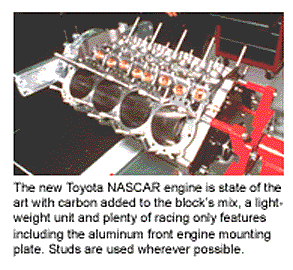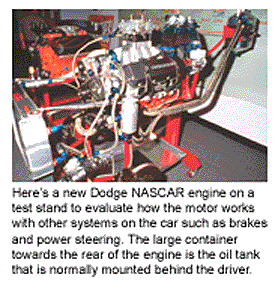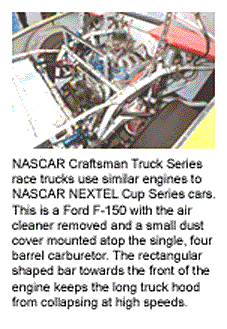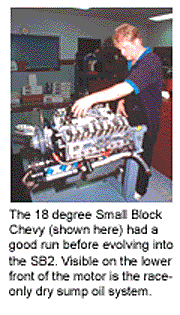The engines in NASCAR’s newly introduced Strictly Stock class of stock car racing in 1949 were literally stock, right off the dealer’s showroom floor. Today, they’re anything but. So what happened?
Evolution. Like any sport or industry, evolution has moved NASCAR racing to where it is today, a multi-million dollar business. The engines, called ‘motors’ by the participants, have also greatly evolved. Years ago, stock car motors were built on the dirt floors of barns, pieced together from new parts, used parts and junkyard scavenging. Now they are assembled from all new and custom made parts in super clean assembly rooms that look more like hospitals than race shops.

The changes that have taken place in NASCAR racing engines are the longest in the list of changes that the cars have undergone. That’s because for about the first three years, most racers thought the key to a better racer was only under the hood. Racers had yet to learn the importance of the chassis or body, so it was the motor that got all the attention. But with NASCAR’s rigid rules, they were limited in what they could do.
As time went on, motors were allowed better and more “racey” components made by the factories and thereby legal. Labeled as Heavy Duty, Off Road, Extreme Usage and even for Police Use, factory parts included high performance cams, higher compression pistons, stronger crankshafts and connecting rods and related parts such as bigger radiators.
When racers couldn’t get past the rules, they found other ways to get the engine to put out more power. The late Smokey Yunick, one of racing’s true characters, always denied cheating. But when he saw something that wasn’t in the rules, it was fair game. Even today, the foundation created in his name is called “It Didn’t Say You Couldn’t.”
When NASCAR said porting and polishing the heads was illegal, Smokey painted them smooth so they would flow better. Another time, to get around the same rule, he created a sandblasting flow bench of sorts to run sand back and forth through the ports to smooth them out for better flow but still look raw, rough and original. Another Smokey trick was to grind his own design onto lobes of a stock cam when the rules called for the use of a stock cam. It was still the stock cam.
When the rules did change, it was from the racers and manufacturers lobbying NASCAR, claiming the new parts would make the racing more cost effective. One example is the use of aluminum heads. While racers in other forms of Motorsports were already using aluminum heads, NASCAR stood its ground and said no. At the time, the top NASCAR teams had head building departments that did nothing but grind and weld iron heads all day long. They would grind them down in some areas and weld them up in others. This would create a better flow of the fuel/air mixture to the valves and more horsepower.

When aluminum heads were allowed, the operation became much more efficient and required fewer man-hours. Today, it’s even quicker as CNC machines do the bulk of the work before being fine-tuned by hand for specific track applications. Some of the teams’ CNC machines often work literally around the clock.
When the introduction of higher-octane gasoline came about in the early ’50s, it allowed manufacturers to build in more compression and create more power. By the late ’90s, racing motors were using up to 20:1 compression for some applications such as restrictor plate racing.
The restrictor plate itself was another NASCAR exclusive. At Daytona and Talladega, NASCAR’s biggest and fastest superspeedways, speeds needed to be controlled after exceeding 200 mph. The thin aluminum plate, mounted under the carb, restricted the flow going into the intakes, thereby cutting the horsepower by about half. And revving the engine higher just made it worse. The plates completely changed the dynamics of the engine and soon, engine departments had sub departments dedicated to the style called “plate motors.” Those motors are run at 7,200 rpm and put out only 430 hp at best.
Up to the late ’80s racing engine blocks were originally made for street cars. The first change was to use truck blocks, which offered more strength than car blocks. But they also contained more iron that, while stronger, was more difficult to machine. So companies started changing the formulas of the chemical make up of the block and “racing only” blocks took on a new composition.
First came the addition of nickel and chrome for easier machining by the race teams. The latest addition is by Toyota who entered NASCAR in 2004. The chemical makeup of the new Toyota block includes carbon, for better strength and toughness yet uses less iron and is a lighter final piece. Toyota also uses bronze bearing lifter bores instead of the block.
One of the last barriers between street and track was the use of dry sump oiling systems. It didn’t take racers long to find out oil on moving parts steals horsepower. The dry sump was an integrated system and used a remote filter or filters to control the flow of oil. At any given time, only a few quarts remain inside the motor with the bulk of the 14-plus quart system running around lines, filters and coolers. Once dry sumps were in place, the cast provisions for street items such as internal, wet oil pumps and screw-on oil filter bosses were no longer needed and removed to reduce block weight. An added bonus that caught NASCAR’s eye and helped sell the idea was that when an engine with a dry sump system did blow on the track, there would now be less oil to clean up.

Another step in racing engine evolution actually came from production cars. One of the improvements seen in the smaller street engines was the use of smaller diameter crankshaft journals. Better metal chemistry had delivered stronger yet smaller components in both street and racing engines and NASCAR builders soon began using smaller journal crankshafts for the advantage of less rotating mass equaling a quicker revving motor. To accommodate this, both Ford and GM cast more metal around those areas to increase the strength in their racing blocks and accommodate the smaller journal sizes. Of course, with lighter crankshafts came lighter pistons and connecting rods.
For a while, engine builders took on an entire line of “qualifying motors” that had yet even lighter components such as pistons, rods and crankshafts. There was even special qualifying oil, which, like the motor, was good for only five laps. The idea was to get the most out of the motor for a better qualifying position. NASCAR quashed the practice by ruling that the same engine had to be used for practice, qualifying and the race at each event.
So where did all the stock engines go? Sadly, there are only three manufacturers left of the dozens that competed in those early days of NASCAR. General Motors dropped all but Chevrolet, Dodge has returned with only the Dodge nameplate and Ford is still there as the lone FoMoCo brand. The current engines they all use are prime examples of NASCAR evolution. (Toyota is involved with NASCAR but only with its Craftsman Truck Series. That may change in the near future as rumors persist that they will move into the prime NASCAR NEXTEL Cup Series.)
The Chevy SB2 is the one used today in NASCAR and is a direct descendant of the original 1955 265 cid small block. The most visible difference is the slight staggering of the lifter holes in the block’s gallery. On all other small blocks, the line of lifter holes, just above the piston bores, are all in line. But the SB2 uses offset lifter bores to give the entirely new heads an offset splay for the valve’s new locations and angles. To create more power, they needed more flow so they changed the location and angle of the valves, achieving that. The new heads have been referred to by some as Ford clones, but in Chevy’s defense, they were just state of the art ’90s NASCAR CNC heads. Short track racers and drag racers had been doing the same basic thing to Chevy Small Block heads for years when their rules allowed. The SB2 would save all that repeated welding and machining to change the contours and valve locations. The new valves are also at different angles. On the intake, a compound angle of 12 and 4 degrees was used while 8 degrees was used on the exhaust valves. With the new valve angles comes new pushrod angles and that’s the reason for the offset lifters that meet the cam on only a slightly staggered contact path. When Chevy moved the valves, they also changed the sequence of the ports. But that was also a factor in keeping the traditional Small Block Chevy look of the two exhaust ports in the middle of the head being next to each other. To maintain that classic Small Block Chevy characteristic, they “mirror imaged” the two middle ports. Some engine builders had hoped Chevy wouldn’t do that as the two ports often combine their exhaust heat to create a hot spot in the middle in relation to the rest of the head. The new heads and intake allowed Chevy to make the runners from the carb to the valves bigger and the contours more manageable and conducive to creating power. The results were a bigger and better flow to the now bigger valves, and that meant more power and quicker revving.

Another distinction of the SB2 is the “dry” intake manifold. All previous Chevy small blocks had intake manifolds that bolted directly to the block and heads also acting as the “roof” or “top” to the lifter gallery. As such, the bottom of the intake was in the oil splash zone inside the engine adding unwanted heat to it. The SB2 has a plate that seals off the lifter gallery and also doubles as a water distribution device for sending water to the heads. Above that plate or cover is the intake that fastens only to the intake portion or the heads, not the block. With the intake removed from the block and away from the hot oil, it keeps the air/fuel mix cooler. The design also takes advantage of the air flowing around the top of the engine to cool the underside of the intake. Another advantage of this design is removal of the intake no longer requires pulling the distributor and re-timing the motor. Likewise, draining any water from the engine is no longer necessary as water is no longer inside the intake.
The return of Dodge created NASCAR’s (and Detroit’s) first made-for-racing-only motor. Designing an engine for the street takes full advantage of all the computer and electronic data acquisition of today and so did this motor. A new computer technology called stereo lithography shows the movement of all flows such as water, fuel mix and oil throughout the engine thus saving countless man-hours determining the optimum flow through the heads and blocks. All that work with stereo lithography and computer models on the flows inside the engine paid off the first time for Dodge. Normally hard to control on an all-out race engine, water temperatures inside the new Dodge are within an incredible three degrees anywhere in the engine. Eliminating hot spots makes for more consistent component life and performance.
Dodge added a number of features to its blocks to save engine builders some time. One is piston squirters. Previously, they needed to be machined, fitted and bolted to the block by team builders. Dodge incorporated eight separate small lines where oil is squirted into each bore and onto the piston for more dedicated lubrication. Tapping into the engine’s dry sump oil management system, the velocity and flow of oil to the bores can be controlled and yet not dilute any of the engine’s horsepower. Another incorporated feature is the sealed lifter valley. Teams normally control oil flow within the block by drilling and tapping the normal oil return holes in the lifter area of the block and installing plugs. They then create their own routes for the oil to return to the pan without hitting moving parts such as the crankshaft, cam, pistons and rods. The design of the new Dodge block seals off the lifter valley and routes the oil literally out the back of the block via braided steel, aircraft-quality lines and returns it to the dry sump oil system.
The Dodge block features not the usual four but six-bolt mains for added strength. There are four internal vertical bolts and two lateral bolts located on the outside of the block – another existing production idea that was also seen on the second generation Hemi in the ’60s. The rod cap bolts used there are, however, noticeably bigger than the old production versions.
For shaving weight off of engine assemblies, front and rear aluminum motor (mounting) plates have seen extensive relief milling and CNC hole drilling. What used to be a thick plate of aluminum now looks more like a well-designed and very intricate miniature suspension bridge holding the engine to the chassis. Even the cast iron blocks have seen some hole drilling for weight loss, too.
Ford has the oldest of today’s equipment, dating back to the ’90s. The blue oval motor is based on the Windsor 351 rather than the Cleveland 351. Racers had used both versions with varying degrees of success. When it came down to choosing between the two, Ford made the decision that its new racing small block would be the Windsor. One of the deciding factors was the bigger mass of metal on the front of the block around the timing chain on the Cleveland block. The Windsor version didn’t have the excess metal and the relatively minor task of creating a separate racing timing chain cover was easily accomplished. In the ’80s Ford made a series of beefed up Windsor blocks with stronger mains and main bearing bulkheads for themselves and the teams to evaluate. The method of “Siamese” cylinder casting also became part of the Ford racing block. This process formed the block’s bores in unison instead of separately for better block strength. More strength around the bores, kept them more stable.
Another Ford change figured prominently in its success. Likely following the adage of the shortest distance between two points is a straight line, Ford race team owner, Robert Yates changed the angle on the flat side of the heads and how they met the block. He cut away aluminum and brought the spark plug end of the heads closer to the combustion chamber – but on an entirely new angle. This new angle lifted the heads higher where they met the intake and the roofs of the ports were raised. That changed the path of the flow from the carb to the valves and a newer, more effective one was created. What resulted was a more direct and faster path for the flow of the air/fuel mixture to the combustion chamber. Not only were the ports elevated by this new process, they were slightly enlarged. When the angle of the head was changed, the intake where it met the heads had to change as well. This was a tremendous undertaking as an entirely new intake manifold design had to be created to match and compliment all the new angles. Once that was done, the flow between the two components was re-established for optimum performance.
Toyota brought to the table an idea that is new to NASCAR racing – Toyota’s NASCAR-approved use of what “wet sleeves.” This process is already in use with Toyota’s open wheel racing engines. The basic principle of sleeving a block is not a new one. In racing, sleeving has two benefits. One is the cost factor, allowing the reuse of a block that has been damaged in the bores. The other is having a certain degree of adjustability in changing the stroke and bore. The problem, until now, has been the more permanent nature of the sleeve. Usually, a sleeve is machined slightly oversize and then installed via press fit into a heated and therefore expanded block, making the fit virtually permanent. A “wet sleeve” with a lip or head on one end, is installed into a normal temperature block with more matching tolerances and is held in place by the head or block (depending how it is installed, from the top or bottom) instead of being press fit. The benefit of the “wet sleeve” is being able to change out the sleeves from a block that has now become more of a parts holder rather than an integral part. With the added ease of installing and removing the sleeves, the additional benefit of having more flexibility for choosing bore and stroke combinations is realized. While NASCAR rules say an engine can’t exceed 358 cid, teams have been known to use motors that were less than the limit to capitalize on the particular torque and power characteristics of a bore and stroke combination. Toyota’s use of the new procedure is sure to spread into the next generations of blocks from the American engine builders. Another step in Toyota’s direction of a block that is a “parts holder” is the extensive use of O-rings instead of gaskets in many areas of the engine. The use of O-rings is easily accomplished by the simple machining of grooves around any holes desired. The benefit is easier and faster assembly and teardowns. The best and most obvious feature is the lack of gasket scraping.
The bottom line on NASCAR racing motors is that today, they are putting out over 800 hp and cranking ’em over 10,000 rpm. Remember, that’s from 358 cid. So when NASCAR calls them STOCK CARS, try not to laugh too much.













